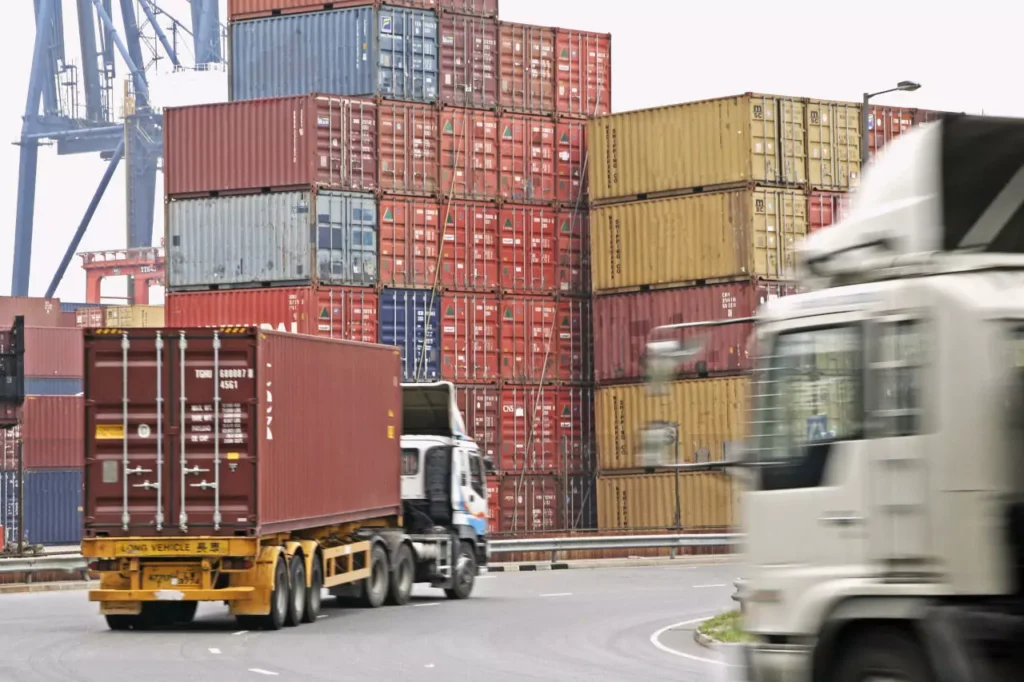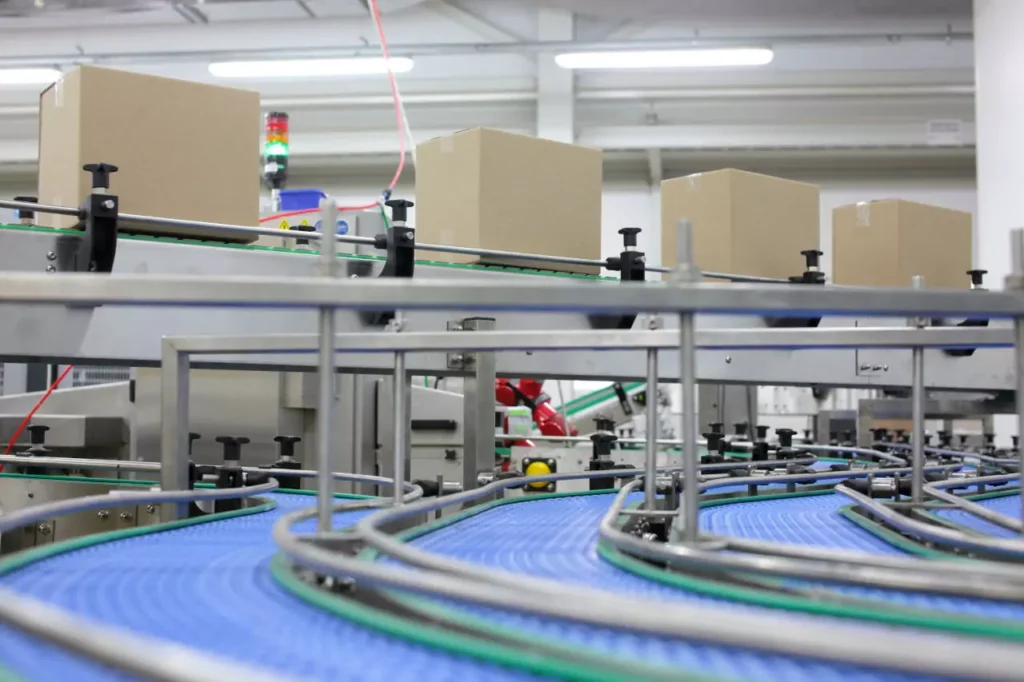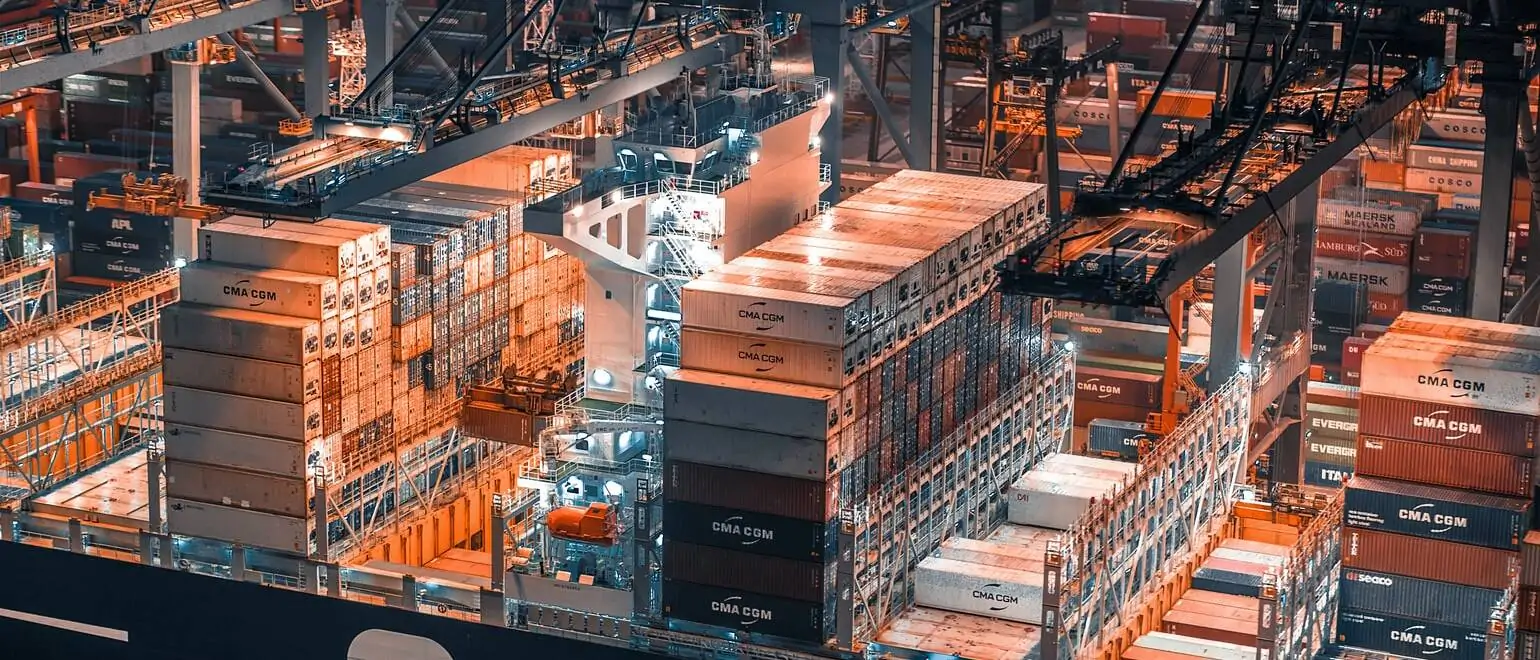Introduction
The term logistics generally refers to the planning, management and control of material and immaterial flows of goods. These flows take place between several companies, within a company or between suppliers and end consumers. Thus, logistics includes the flow of goods and information, but also the flow of people. In addition, logistics represents both an industry and an operational function, as well as an interdisciplinary science.
Logistics definition and the 6 Rs
In the course of the historical development of logistics, certain criteria have emerged that describe the tasks and goals of logistics in summary. They define the term in a simplified way and are known as the 6 Rs of logistics. Accordingly, in logistics, everything revolves around delivering the
- right goods, at the
- right time, in the
- right composition (quantity) and the
- quality (condition) at the
- right price (cost) at the
- right place.
Logistics is therefore about making goods available. The 6 Rs show which aspects must be carried out correctly in order to successfully fulfill a logistical task. The development of a logistics definition can also be seen from these criteria: For many years, the focus was on the 4 Rs: the right product, in the right quality, at the right time, in the right place. However, additional objectives have since been added to take account of the reduced vertical range of manufacture, for example in just-in-time production. These additional criteria include quantity and costs, which then established the 6 Rs as the core elements of logistics.
However, this development is not yet complete, because people also speak of 7 R or 7 R+, since the control and importance of logistical processes is increasing both in industrial production and in society as a whole. These additional Rs include, among other things:
- The right information
- The right packaging
- The right customer
If warehouse quantities are to be minimized, then a corresponding flow of information must be guaranteed, for example, via ERP systems, in order to always know where and how much of which product is stored or where it is currently on its transport route. The right packaging has become an equally important factor in logistics; it should ensure product quality, save space and also be environmentally friendly. The right customer is about a change in perspective within the entire service and supply chain. This does not only mean the right customer at the very end of the supply chain, but every point in the supply chain that is downstream of another. Through this kind of (internal )customer focus, every point becomes a supplier and a customer at the same time.
The modern supply chain is a delivery and supply chain that forms a networked, process-oriented materials management system. From demand to production to final delivery, the entire supply chain is covered. This includes a corresponding information management system and also the technical solutions that are increasingly being used in all areas. Business, internal and social aspects increasingly define what logistics must achieve and determine which individual services need to be improved. The following fields of action, among others, can be derived from this:
- Shortening delivery times
- Increasing delivery capacity
- Increasing delivery flexibility
- Increasing delivery quality
- Improving delivery transparency
- improving security of supply
Each individual logistics service has a certain dependent relationship with the other services. This interdependent relationship can, when optimizing a service, have almost no effect on another, and thus be relatively neutral. However, it is equally possible that improving one aspect has a supportive effect on another or even has a negative effect on another logistics service. In any case, optimizations in a logistics system and the associated measures either require increased costs or have a negative impact on other delivery performance values.
Areas in logistics
From a business management perspective, logistics is divided into four subsystems:
- procurement logistics
- production logistics
- distribution logistics
- disposal logistics
Procurement logistics, which deals with the ordering of raw materials and other materials as well as the selection of suppliers, is at the beginning of the value chain. The focus here is on optimal, timely delivery. In-house warehousing, handling and transport processes are planned, controlled and monitored in production logistics. An important aspect of production logistics is keeping production costs low or reducing them. Distribution logistics, also known as sales or marketing logistics, primarily involves the distribution and delivery of goods, which can be inventories or information. It is also the responsibility of distribution logistics to optimize packaging and improve delivery service. While the three subsystems described in the supply chain are linked one after the other, they are all permeated by disposal logistics, which ensures that waste, goods that are no longer in use and other residues are disposed of or recycled along the entire value creation process. Due to the very broad and specific areas of application, disposal logistics can be defined with varying degrees of specificity, which is why it is also referred to as return logistics, reverse logistics, take-back logistics or reverse logistics, depending on the context.
Another classification of logistics takes place at the functional level, where different functional areas are identified and corresponding areas of logistics can be named. For example, there is internal transport and also external transport. Inventory management with order picking and planning with the operation of storage systems represent two further functional areas. Other areas that can be derived from the respective function include goods handling (loading, unloading, reloading), goods inspection, handling and packaging.

Transport logistics is a central part of the global economy. Image rights: © Diezer – Fotolia.com
However, since logistics is particularly process-oriented, terms have been established for sub-areas that subsume all logistical tasks in a specific comprehensive process section or for which logistical processes are more individually defined in order to distinguish them from other areas and industries. These sub-areas can then have intersections with other areas, also include them and fulfill individual functions together. In certain application contexts, there are also separate logistics terms due to the special circumstances, such as pharmaceutical logistics, hospital logistics or contract logistics. In general, however, the following specifications, among others, are considered sub-areas of logistics:
Warehouse logistics
The choice of location for the warehouse, the design of the ideal storage system, the storage technology and the warehouse organization consist of logistical measures that must be planned, implemented and controlled. Furthermore, the operation of a warehouse is also part of warehouse logistics.
Transport logistics
The physical transport of goods by road, air and water from one place to another and the associated tasks, such as providing consignment notes, calculating transport time and planning the use of transport, technology and workforce, are all part of transport logistics.
Intralogistics
Intralogistics usually covers the complete logistical processes at a specific location; this can be either a manufacturing company or a distribution center. Depending on the context, it includes production logistics, warehouse logistics, packaging logistics and distribution logistics. The entire material flows within a location form the core of intralogistics.
Packaging logistics
Packaging logistics includes the provision and disposal of packaging material and the selection of the same in relation to various criteria: cost savings, quality assurance of the transported goods, maintaining a cold chain, and environmental compatibility. The introduction of technologies such as RFID has given packaging logistics even greater importance, as it is thus possible not only to transport goods with the packaging, but also to transmit or generate information. This results in an intersection with information logistics.
Information logistics
Information must be provided in line with the flow of materials and the transportation of inventory. The current location and condition of the goods should be able to be transmitted in real-time and at any time. This also includes the strategic planning and development of all information systems necessary for the exchange of information and the processing of business processes. The application of blockchain technology in supply chain management is also part of the information logistics subfield.
Store logistics
The regular supply of stores in a retail chain, especially in the food retailing sector with thousands of fast-moving items, is subject to special requirements, for example with regard to delivery, warehousing, the deployment of employees and the restocking of shelves, which are all subsumed under the term store logistics.
Last-mile logistics
In mail order and e-commerce, the last mile, i.e. the route from the mail order company’s distribution center to the end consumer’s delivery address, is the most expensive, laborious and complex part of the entire transport route. Delivery over the last mile is not only a logistical challenge from an economic point of view, but also in terms of increased traffic in urban areas and also with regard to more environmentally friendly solutions and alternatives such as cargo bikes, parcel stations or micro-depots in city centers.
All these areas of logistics, regardless of the criteria by which they are divided, are subject to elementary logistical processes that present their own challenges and accordingly form their own fields of action for optimization.
Processes in logistics
There are numerous processes in logistics, with each individual process already reaching a very high degree of complexity. In all sub-steps or sub-processes, information is also transmitted and exchanged that is essential for the smooth running of the entire process chain. As much as the specific logistical requirements in the respective areas of application differ, the actual logistics processes are very similar.

The use of recording systems is essential, especially when using materials handling technology. Image rights: © endostock Fotolia.com
Depending on the industry and company, the processes are of varying complexity, while there are other processes that always present a challenge in terms of planning and implementation, as is the case with rush orders, for example. A central point in the logistics of a company is the warehouse and the corresponding processes. Here, everything revolves around the optimal utilization of spatial resources and the minimization of operating costs, which is continuously monitored using key figures such as the stock range. For this reason, all logistics processes must be coordinated and closely interlinked.
Such optimal coordination requires the use of know-how, time, money and skilled workers, which is why both external and internal expertise is used in logistics processes. Despite the relatively comparable processes, the change or optimization of logistics processes is always very individual, since the circumstances and specific local conditions differ enormously. The aim is to implement logistics processes as automatically as possible. The following simplified list shows the processes in logistics from delivery to goods issue and briefly describes them:
Logistics processes: goods receipt and delivery
The delivery of goods requires communication with the supplier. The minimum level of this information exchange consists of the order confirmation and, if applicable, the shipping confirmation. This process can be largely automated using an ERP system.
When the goods arrive at the company premises, for example by truck, the unloading process must be scheduled and controlled by designating a specific area and time window. After unloading, the inventory is notified and checked, and recorded in the company’s inventory management system. The delivered inventory is then assigned a storage location. If the inventory was delivered in reusable containers, these must be booked, returned or exchanged accordingly, for which there are also separate container management systems.
Logistics processes: intralogistics and warehousing
From the incoming goods area, the delivered goods are transported to their storage location, for example by means of industrial trucks. The movements of vehicles and workers in the warehouse are subject to logistical specifications in order to use all resources as efficiently as possible through forklift control systems or a higher-level control center. As soon as materials are needed from the warehouse, the picking and selection of the inventory takes place, which is then transported to its destination; this can be a production facility in the company or the shipping area for delivery. Similarly, materials handling systems (material flow systems) can be connected in this process step, which automatically take over the majority of the transport route.
Logistics processes: production and order fulfillment
The logistical supply of production usually follows defined Kanban processes and also relies on complex implementations such as the Jidoka principle to trigger the replenishment process when replenishment is actually needed, not too early and, above all, not too late, so that the required materials can be delivered from the warehouse just in time. Serial and batch numbers are used in production to ensure that the origin, nature and refinement of the goods can be traced all the way from and to production to the end consumer. The products from production can then also be packed there, but this usually happens in distribution.
Logistics processes: shipping and distribution
When goods are shipped, the products are packed for delivery. The more parcels shipped per day, the larger this area is and the more complex this process can be. During the preparation for shipment, the CEP service providers are selected and the shipment is organized. This also includes affixing the corresponding labels or tags to the parcels and providing them with the necessary documents (delivery note, for example). This entire process can also be automated to a large extent. Another process step that is very prone to errors is freight cost management, where the invoices for shipping are managed and checked, which is why a high degree of automation has been established here as well in order to minimize manual intervention as much as possible. After all the processes have been completed, the parcels are ready for the CEP service provider to pick up; as with goods receipt, the aim here is to keep downtimes as short as possible and to optimize loading. If a package is returned as a return shipment, it also has to go through various processes. These include a quality inspection, possible reprocessing and either restocking or disposal. If a new order for the product already exists, it can also be repackaged and shipped instead of being restocked.
As described above, logistical processes consist of many small individual steps that vary from industry to industry and from company to company. For example, a supplier in the automotive industry faces different challenges in its processes than a large online vendor in its distribution center. When the latter processes 7,500 orders per minute at peak times during Cyber Week, it is clear how crucial it is that the individual process steps are as efficient as possible and that they interlock smoothly. Every second wasted and every sub-step that is not optimized to the maximum has a cumulative negative effect on the operating result.
Logistics careers
The logistics industry is the third largest economic sector in Germany, after the automotive industry and trade. Accordingly, the professions in logistics are very broadly based and cover a very wide range that extends across all industries.
The fields of activity of logistics professions include:
- Freight forwarding and logistics services
- Warehousing
- Picking
- Distribution
- Disposition
- Transportation
- Supply chain management
- Logistics planning
Logistics tasks also play a major role in aviation and shipping, and there is also a great demand for logistics-specific requirements in IT, for IT specialists, application developers and information managers. The same applies to the areas of sales and controlling.
Specific training occupations and positions are as follows:
-
- Management assistant in freight forwarding and logistics services
- Management assistant in courier, express and postal services
- Warehouse operative
- Warehouse logistics specialist
- Warehouse manager
- Order picker
- Head of materials management
- Import/export specialist
- Head of shipping
- Materials requirements planner
- Forklift truck driver
- Professional driver
- Fleet manager
- Purchaser
- Supply chain manager
- Logistics planner
There are also more and more courses of study that deal explicitly with logistics or general courses of study, such as business administration, that offer a focus or specialization in logistics.
Summary
Logistics involves planning, managing and controlling the flow of inventories, information and people. As a result, both the economy and society are permeated by logistical requirements, tasks, processes and solutions. Logistics can be divided into different sub-areas and consists of numerous individual processes that interact to ensure a smooth flow of the overall process. Particularly in the economic sector, logistics is constantly evolving with an increased increase in the degree of automation. The use of the latest technologies in logistics means that process costs and process times, as well as error rates, are constantly being reduced. The modern availability of goods requires a constantly increasing transparency and speed, which can also be seen in the development of the 6 Rs of logistics to the 7 R+ of logistics.
